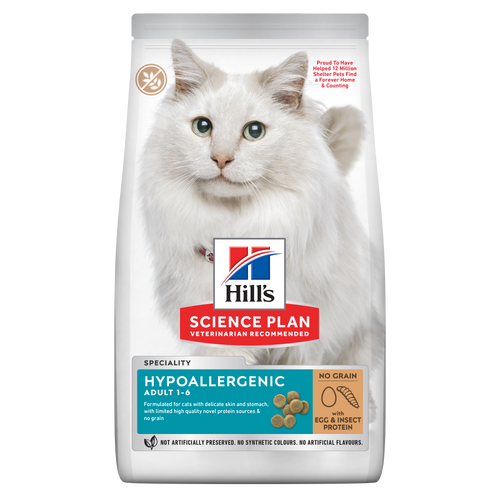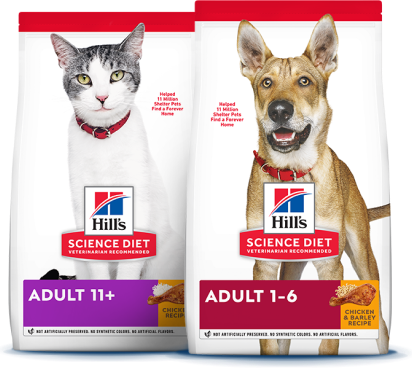
-
Find the right food for your petTake this quiz to see which food may be the best for your furry friend.Find the right food for your petTake this quiz to see which food may be the best for your furry friend.Featured products
 Small & Mini Mature Adult 7+ Dog Food
Small & Mini Mature Adult 7+ Dog FoodHill's Science Plan Small & Mini Breed Mature Adult Dog Food with Chicken is a complete pet food, specially formulated with ActivBiome+ Multi-Benefit Technology.
Tailored nutrition to support graceful ageing in small dogs. Specially made with a synergistic blend of nutrients for energy & vigor.Shop Now Perfect Digestion Small & Mini Adult Dog Food
Perfect Digestion Small & Mini Adult Dog FoodHill's Science Plan Perfect Digestion Small & Mini Breed Adult Dog Food with Chicken & Brown Rice supports ultimate digestive well-being & a healthy microbiome.
Shop Now Perfect Digestion Large Breed Puppy Food
Perfect Digestion Large Breed Puppy FoodPrecisely balanced nutrition with Hill's ActivBiome+ prebiotic blend actively contributes to supporting digestive health and overall well-being to help your pet feel their best
Shop NowFeatured products Hypoallergenic Dry Cat Food
Hypoallergenic Dry Cat FoodHILL'S SCIENCE PLAN Hypoallergenic Adult cat food with egg & insect protein is a complete pet food for adult cat 1–6 years old. It's formulated for cats with delicate skin and stomach, with limited high quality novel protein sources & no grain.
Shop Now Hairball & Perfect Coat Adult Cat Food
Hairball & Perfect Coat Adult Cat FoodHill's Science Plan HAIRBALL & PERFECT COAT Adult cat food with Chicken is specially formulated to effectively help avoid hairball formation in adult cats while promoting a beautiful coat. Thanks to its mix of essential Omega-6 fatty acids, this food benefits the cat's skin and fur keeping them healthy and shiny. Our Advanced Fibre Technology helps reduce hairballs by naturally promoting their passage through the gut. This food is formulated with high-quality protein for a perfectly balanced, great-tasting recipe.
Shop Now Kitten Food
Kitten FoodTender chicken chunks in gravy for kittens, with omega-3s for healthy eye & brain development and high-quality protein to support muscle growth. With balanced minerals to promote strong bones & teeth.
Shop Now -
Dog
- Dog Tips & Articles
-
Health Category
- Weight
- Food & Environmental Sensitivities
- Urinary
- Digestive
- Joint
- Kidney
-
Life Stage
- Puppy Nutrition
- Adult Nutrition
- Senior Nutrition
Cat- Cat Tips & Articles
-
Health Category
- Weight
- Skin & Food Sensitivities
- Urinary
- Digestive
- Kidney
-
Life Stage
- Kitten Nutrition
- Adult Nutrition
Featured articles Pet Food Storage Tips
Pet Food Storage TipsWhere you store your cat and dog food can make a big difference in the quality and freshness once it is opened. Here are some common questions and recommendations for optimal storage for all of Hill’s dry and canned cat and dog food.
Read More Understanding Your Pet's Microbiome
Understanding Your Pet's MicrobiomeLearn what a pet's microbiome is, how it contributes to your pet's gut & overall health, and why nutrition is important in maintaining healthy microbiomes.
Read More The Right Diet For Your Pet
The Right Diet For Your PetLearn what to look for in healthy pet food & nutrition, including ingredients, quality of the manufacturer, your pet's age, and any special needs they have
Read More -
Feed with confidence
How to switch or transition your pets’ food
Feed with confidence
How to switch or transition your pets’ food

Upgraded Science Diet formulas are on the way
Coming soon, select Science Diet foods will have updated formulas with breakthrough innovations developed by our team of over 200 veterinarians and nutritionists.
Featuring our latest science — ActivBiome+ Ingredient Blend


Be sure to plan ahead for a seamless transition to your upgraded formula.

Transitioning your pet to a new food
There will likely be a time when your pet will need to switch to a new food, whether it’s to a therapeutic nutrition, a new formula or they just need a food that better suits their life stage. Pets should gradually transition to new food to avoid stomach upset. Here are some tips for transitioning your pet to a new food.
Transitioning your pet to a new food
There will likely be a time when your pet will need to switch to a new food, whether it’s to a therapeutic nutrition, a new formula or they just need a food that better suits their life stage. Pets should gradually transition to new food to avoid stomach upset. Here are some tips for transitioning your pet to a new food.



Determine the right amount per serving

Follow this 7-day transition schedule


Follow this 7-day transition schedule



Consider making your pet’s dry food more like wet food
While it’s not a necessity, some pets are a little more stubborn than others, and a little wet food can make all the difference. To avoid going over their daily caloric intake requirements, be sure to check with your vet on the proper serving sizes.

Consider making your pet’s dry food more like wet food
While it’s not a necessity, some pets are a little more stubborn than others, and a little wet food can make all the difference. To avoid going over their daily caloric intake requirements, be sure to check with your vet on the proper serving sizes.
- Softening dry food
- Adding taste enhancers
Combine wet & dry food

Add the following “enhancers” to make your pet’s dry food more appealing





Find the right food for your pet
The right nutrition is essential to pets living happy, healthy lives. See which foods fit your pet's unique nutritional needs here.

